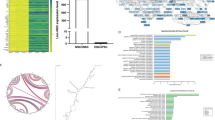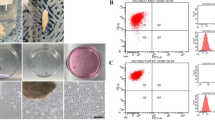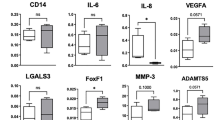Abstract
Objective
To explore the expression change of stem cell-derived neural stem/progenitor cell supporting factor (SDNSF) gene in the injuried spinal cord tissues of rats, and the relation between the expressions of SDNSF and nestin.
Methods
The spinal cord contusion model of rat was established according to Allen’s falling strike method. The expression of SDNSF was studied by RT-PCR and in situ hybridization (ISH), and the expression of nestin was detected by immunochemistry.
Results
RT-PCR revealed that SDNSF mRNA was upregulated on day 4 after injury, peaked on day 8–12, and decreased to the sham operation level on day 16. ISH revealed that SDNSF mRNA was mainly expressed in the gray matter cells, probably neurons, of spinal cord. The immunohistochemistry showed that accompanied with SDNSF mRNA upregulation, the nestin-positive cells showed erupted roots, migrated peripherad and proliferation on the 8-day slice. However, the distribution pattern of these new cells was different from that of SDNSF-positive cells.
Conclusion
(1) SDNSF is expressed in the gray matter of spinal cord. The expression of SDNSF mRNA in the spinal cord varies with injured time. (2) The nestin-positive cells proliferate accompanied with spinal cord injury repair, but do not secrete SDNSF.
摘要
目的
观察大鼠脊髓损伤后干细胞来源的神经干细胞生存因子(SDNSF)mRNA在大鼠正常和损伤脊髓的表达变化, 以及SDNSF的表达与VI类中间丝蛋白的表达之间的关系。
方法
按改良的Allen重物打击法制备大鼠脊髓损伤模型, 采用RT-PCR、 原位杂交方法, 观察SDNSF mRNA在大鼠脊髓中的表达位置及在损伤脊髓中的表达变化。 应用免疫组化的方法, 显示脊髓中nestin的表达。
结果
RT-PCR 检测 SDNSF mRNA 在正常大鼠脊髓中的表达, 损伤后4天SDNSF的mRNA 表达上升, 损伤8天到达高峰, 此后SDNSF的mRNA表达逐渐减少, 到16天恢复到正常水平; 脊髓切片原位杂交结果发现SDNSF的mRNA阳性细胞主要分布于脊髓灰质细胞中, 可能是神经元细胞, 结果表明正常脊髓可表达SDNSF; 脊髓损伤后8天, 原位杂交显示SDNSF阳性细胞明显增多。 同时与此切片相邻层面的切片免疫组化证实nestin阳性细胞增殖、 变大、 向周围发出突起, 但这些阳性细胞在分布上与SDNSF无关。
结论
(1)SDNSF在脊髓中表达于灰质, 脊髓损伤后SDNSF的mRNA表达随时间发生变化。 (2)随着脊髓损伤的修复, nestin阳性细胞增殖, 但是这些细胞并不表达SDNSF。
Similar content being viewed by others
Reference
Kanda T, Iwasaki T, Nakamura S, Ueki A, Kurokawa T, Ikeda K, et al. FGF-9 is an autocrine/paracrine neurotrophic substance for spinal motoneurons. Int J Dev Neurosci 1999, 17: 191–200.
Shingo T, Sorokan ST, Shimazaki T, Weiss S. Erythropoietin regulates the in vitro and in vivo production of neuronal progenitors by mammalian forebrain neural stem cells. J Neurosci 2001, 21: 9733–9743.
Arsenijevic Y, Weiss S, Schneider B, Aebischer P. Insulin-like growth factor-I is necessary for neural stem cell proliferation and demonstrates distinct actions of epidermal growth factor and fibroblast growth factor-2. J Neurosci 2001, 21: 7194–7202.
Taupin P, Ray J, Fischer WH, Suhr ST, Hakansson K, Grubb A, et al. FGF-2-responsive neural stem cell proliferation requires CCg, a novel autocrine/paracrine cofactor. Neuron 2000, 28: 385–397.
Toda H, Tsuji M, Nakano I, Kobuke K, Hayashi T, Kasahara H, et al. Stem cell-derived neural stem/progenitor cell supporting factor is an autocrine/paracrine survival factor for adult neural stem/progenitor cells. J Biol Chem 2003, 278: 35491–354500.
Black P, Markowitz RS, Damjanov I. Model of spinal cord injury: Part 3. Dynamic load technique. Neurosurgery 1988, 22(1 Pt 1): 51–60.
Houtani T, Nishi M, Takeshima H, Sato K, Sakuma S, Kakimoto S, et al. Distribution of nociceptin/orphanin FQ precursor protein and receptor in brain and spinal cord: a study using in situ hybridization and X-gal histochemistry in receptor-deficient mice. J Comp Neurol 2000, 424: 489–508.
Xu HW, Fan XT. Effect of a antisense oligonucleotide to noggin on the expression of nestin and GFAP in the hippocampus of adult rats. Neurosci Bull 2005, 21: 319–323.
Ernst C, Christie BR. The putative neural stem cell marker, nestin, is expressed in heterogeneous cell types in the adult rat neocortex. Neuroscience 2006, 138: 183–188.
Ferretti P, Zhang F, O’Neill P. Changes in spinal cord regenerative ability through phylogenesis and development: lessons to be learnt. Dev Dyn 2003, 226: 245–256.
Okada S, Nakamura M, Katoh H, Miyao T, Shimazaki T, Ishii K, et al. Conditional ablation of Stat3 or Soc3 discloses a dual role for reactive astrocytes after spinal cord injury. Nat Med 2006, 12: 829–834.
Zhang B, McGee B, Yamaoka JS, Guglielmone H, Downes KA, Minoldo S, et al. Combined deficiency of factor V and factor VIII is due to mutations in either LMAN1 or MCFD2. Blood 2006, 107: 1903–1907.
Author information
Authors and Affiliations
Corresponding author
Rights and permissions
About this article
Cite this article
Feng, Y., Gao, YL., Ding, F. et al. Expression change of stem cell-derived neural stem/progenitor cell supporting factor gene in injured spinal cord of rats. Neurosci. Bull. 23, 165–169 (2007). https://doi.org/10.1007/s12264-007-0024-z
Received:
Published:
Issue Date:
DOI: https://doi.org/10.1007/s12264-007-0024-z




